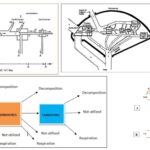IB Biology 60 Views 1 Answers
Sourav PanLv 9November 9, 2024
How is a nerve impulse initiated, and what is the role of the threshold potential in this process?
How is a nerve impulse initiated, and what is the role of the threshold potential in this process?
Please login to save the post
Please login to submit an answer.
Sourav PanLv 9May 15, 2025
A nerve impulse is initiated through a series of electrochemical changes in a neuron, primarily involving the movement of ions across the neuronal membrane. The threshold potential plays a critical role in this process by determining whether an action potential will be generated.
Initiation of a Nerve Impulse
- Resting Membrane Potential:
- Neurons maintain a resting membrane potential of approximately -70 mV, where the inside of the cell is negatively charged relative to the outside. This state is primarily maintained by the sodium-potassium pump, which actively transports sodium (Na++) out of the cell and potassium (K++) into the cell.
- Stimulus Application:
- When a neuron receives a stimulus (which could be electrical, chemical, or mechanical), it causes a change in membrane potential. If this change is sufficient to depolarize the membrane to a certain level, known as the threshold potential (typically around -55 mV), an action potential is triggered.
- Threshold Potential:
- The threshold potential is crucial because it represents the critical level of depolarization needed to open voltage-gated sodium channels. If the stimulus is subthreshold (not strong enough), it will not result in an action potential. Conversely, if the stimulus reaches or exceeds this threshold, it initiates a rapid depolarization phase.
Role of Threshold Potential
- Opening of Voltage-Gated Sodium Channels:
- Upon reaching threshold, voltage-gated Na++ channels open rapidly, allowing Na++ ions to flood into the neuron. This influx of positive ions further depolarizes the membrane, creating a positive feedback loop that accelerates depolarization.
- Action Potential Generation:
- As more Na++ channels open and more sodium enters, the membrane potential can rise sharply to around +30 mV. This rapid change in polarity constitutes an action potential, which propagates along the axon as a wave of depolarization.
- Propagation Mechanism:
- The action potential travels along the axon by sequentially opening adjacent voltage-gated Na++ channels through local currents generated by ion movements. Each segment of the axon undergoes depolarization and then repolarization as Na++ channels close and voltage-gated K++ channels open, allowing K++ to exit the neuron.
- All-or-None Response:
- The action potential follows an all-or-none principle; once threshold is reached, an action potential will occur with a consistent amplitude and duration regardless of the strength of the stimulus beyond that point.
0
0 likes
- Share on Facebook
- Share on Twitter
- Share on LinkedIn
0 found this helpful out of 0 votes
Helpful: 0%
Helpful: 0%
Was this page helpful?




